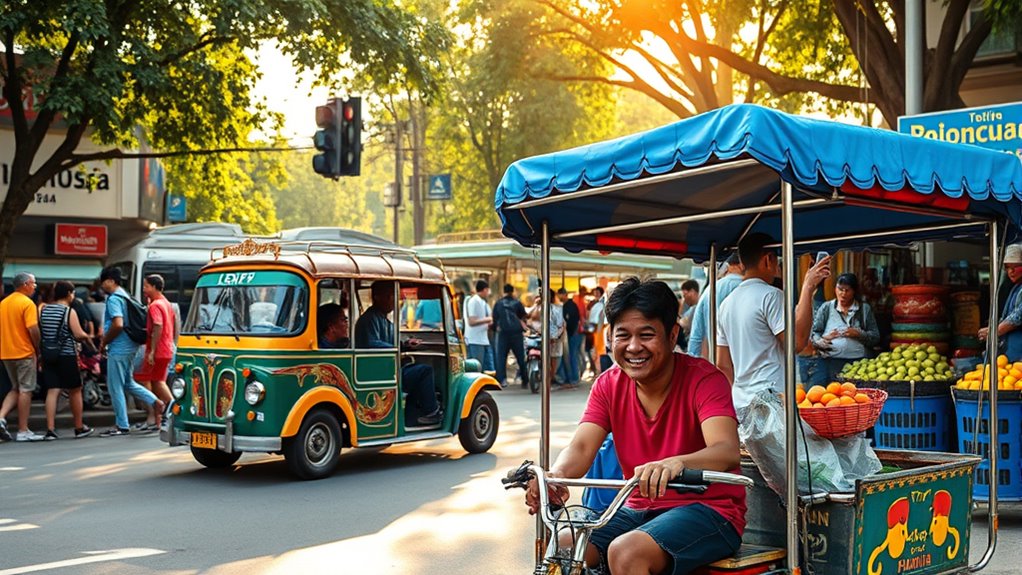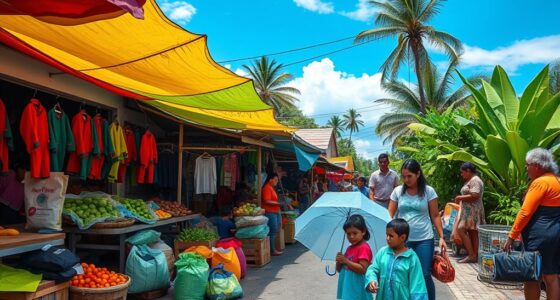Maneuvering public transportation in the Philippines can be a rewarding experience. You’ll find buses, jeepneys, and tricycles as affordable options to travel around. Jeepneys showcase vibrant Filipino culture, while tricycles are perfect for quick trips. Ride-hailing services like Grab make getting around a breeze. Just remember to have cash handy and be flexible with your plans. If you want to explore more about unique travel tips and options, there’s so much more to discover!
Key Takeaways
- Familiarize yourself with various modes of public transportation, including buses, jeepneys, tricycles, and ride-hailing services like Grab and Angkas.
- Always carry cash for fares, as most public transport options do not accept electronic payments.
- Download navigation apps to understand routes and schedules, allowing for better travel planning and flexibility.
- Travel during off-peak hours to avoid heavy traffic and ensure a smoother journey.
- Learn basic Filipino phrases and write down destinations to facilitate communication with locals.
Overview of Public Transportation in the Philippines

As you explore the Philippines, you’ll quickly notice that public transportation plays an essential role in daily life.
Public transportation in the Philippines is vital, connecting urban areas to remote provinces and shaping daily life.
Managed by the Department of Transportation (DOTr) and the Land Transportation Franchising and Regulatory Board (LTFRB), the system offers a mix of jeepneys, commuter trains, tricycles, and ferries.
While these options connect urban centers to remote provinces, challenges like traffic and infrastructure issues can impact efficiency and reliability.
Ongoing modernization efforts aim to enhance the commuter experience and promote environmental sustainability.
Regulations like the Local Public Transport Route Plan (LPTRP) guide operations, encouraging consolidation for better service.
Buses: Affordable and Accessible

Public buses are among the most affordable and accessible options in the Philippines’ public transportation system.
You’ll find several types, including provincial, city, and Point-to-Point (P2P) buses, each catering to different travel needs. Provincial buses have set schedules, making trip planning easier, while city buses often operate without fixed times. P2P buses provide direct service between specific points.
You can choose between air-conditioned and non-air-conditioned options, with air-conditioned buses offering more comfort. Fares are distance-based, and discounts are available for seniors, students, and persons with disabilities.
Payments are typically made in cash, but some services accept Beep cards. Just keep smaller bills handy, as many buses prefer exact fare payments.
Enjoy the ride!
Jeepneys: The Iconic Filipino Ride
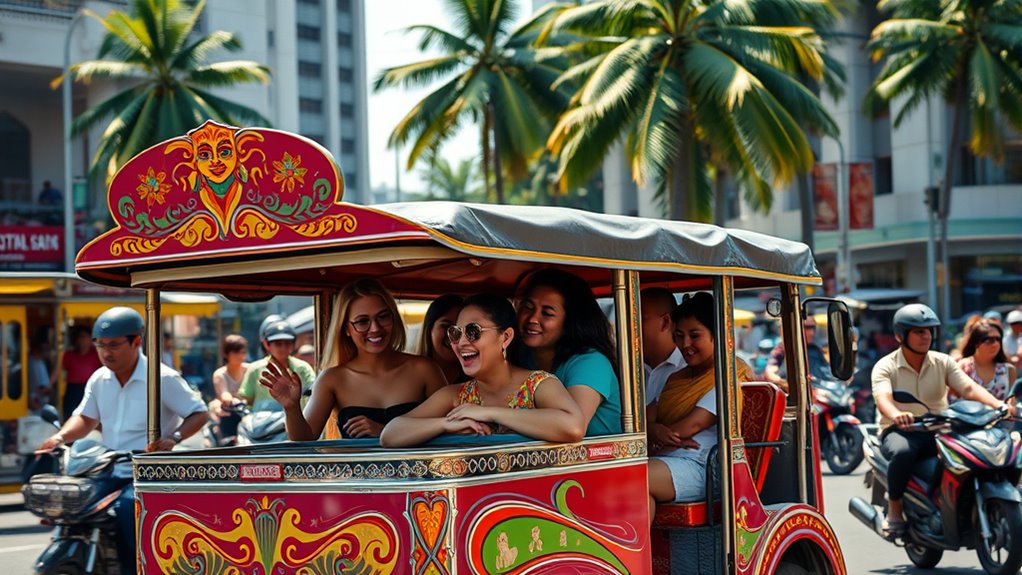
Jeepneys, often hailed as the quintessential Filipino ride, offer a vibrant glimpse into the country’s culture and history.
Originating from surplus U.S. military vehicles after World War II, Filipinos transformed them into unique public transport. Their colorful exteriors, often showcasing artistic designs, reflect local culture and serve as a canvas for local artists.
The jeepney, a vibrant symbol of Filipino ingenuity, transforms surplus military vehicles into colorful public transport masterpieces.
You’ll find them traversing both urban and rural areas, displaying route signs on their windshields. To board, simply hail one by waving or calling out.
Fares are affordable, typically starting at around P9, and you can pass your fare to the driver through fellow passengers.
Riding a jeepney isn’t just transportation; it’s an experience that immerses you in the essence of Filipino identity.
Tricycles: Short Trips Made Easy
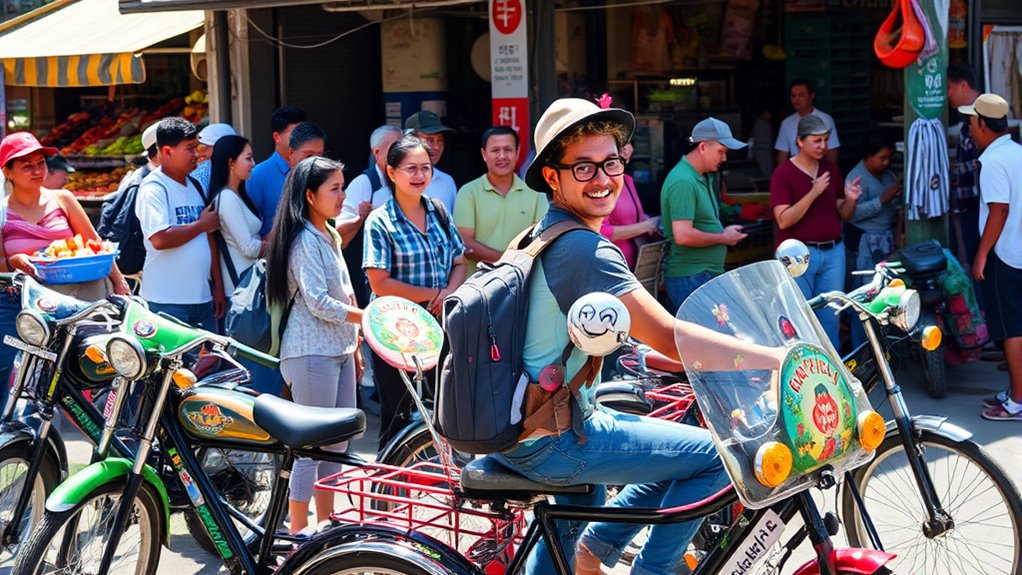
Tricycles are a convenient choice for quick trips, especially in rural areas where larger vehicles can’t easily navigate. These motorcycles with sidecars can carry 2 to 7 passengers, making them perfect for short distances.
You’ll find them readily available, often serving as last-mile transport from larger hubs. Fares can vary, so it’s wise to negotiate before hopping in. While they’re generally affordable, comfort levels can differ based on design.
For safety, wearing a helmet is advisable, particularly on open roads. Just be cautious; drivers may be aggressive, and road conditions can be rough.
Despite some noise and pollution, tricycles are a popular option for both locals and tourists alike, helping to fill transport gaps in many areas.
Ride-Hailing Services: Grab and Angkas
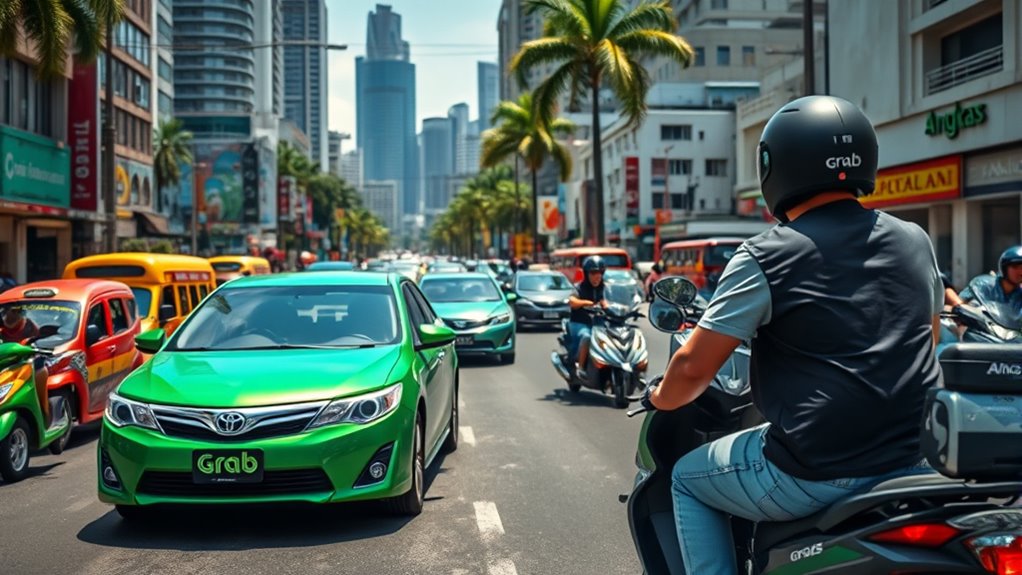
When you’re looking for a quick and efficient way to get around, ride-hailing services like Grab and Angkas offer convenient options tailored to your needs.
Angkas specializes in motorcycle taxis, perfect for maneuvering through heavy traffic, while Grab provides a range of vehicles, from sedans to SUVs, for various passenger needs.
Angkas offers motorcycle taxis for navigating traffic, while Grab caters to diverse passenger needs with various vehicle options.
Both services prioritize safety, with Angkas boasting a 99.997% safety rate and Grab featuring in-app tracking and driver background checks.
You can easily download either app on Android or iOS.
With real-time tracking and quick booking, you can get to your destination smoothly.
For congested areas, Angkas might save you time and money, while Grab is ideal for longer trips.
Taxis: Varieties and How to Use Them
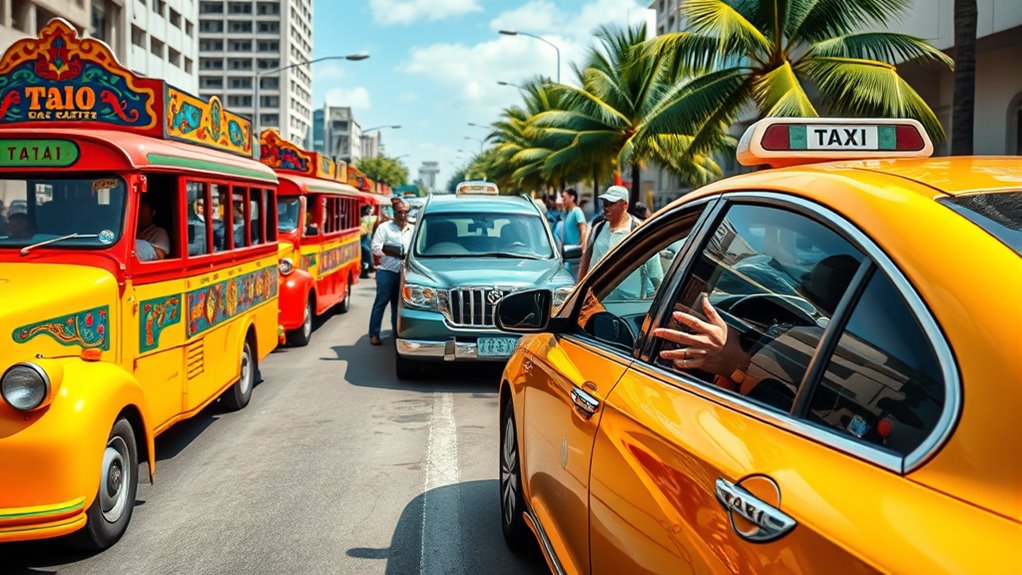
Taxis are a popular choice for getting around Metro Manila, offering a straightforward and efficient way to travel.
You’ll find two main types: regular white taxis and yellow-metered airport taxis. Regular taxis are widely available, with fares ranging from PHP 180 to PHP 240. Always insist on using the meter to guarantee you’re charged fairly.
Yellow-metered taxis, which you can only find at airports, cost about PHP 300 to PHP 450—50% more than regular taxis.
When hailing a taxi, check for a visible driver ID and verify the vehicle has a valid operating permit. Be cautious of fixed rates and keep an eye on your belongings during the ride for a safe experience.
Metro Manila’s Rail Transit System
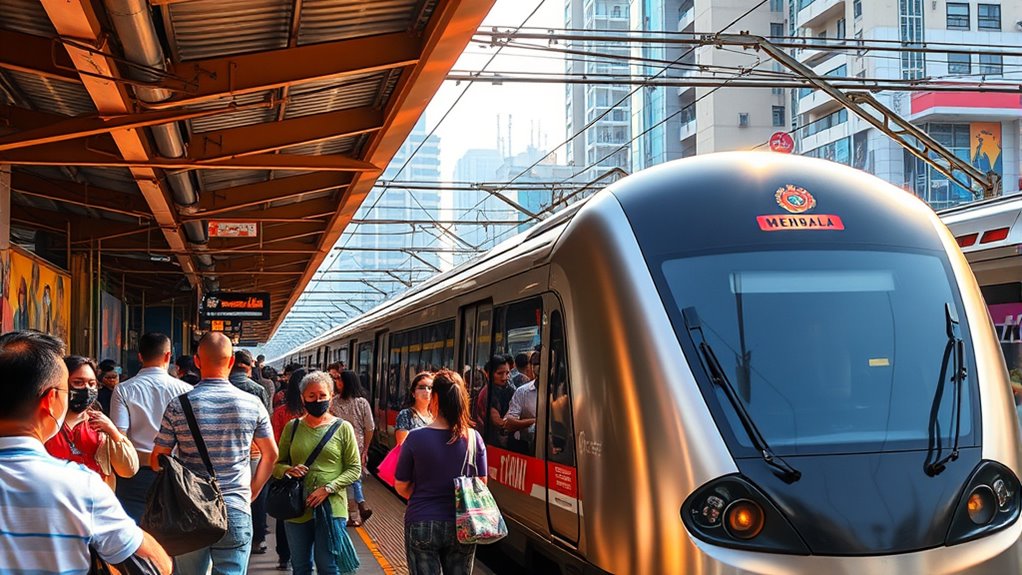
Metro Manila’s rail transit system serves as an essential lifeline for millions of commuters, efficiently connecting various parts of the metropolis.
It includes the Manila Light Rail Transit System (LRT), the Manila Metro Rail Transit System (MRT), and the Philippine National Railways (PNR) lines, covering a total length of 60.2 km.
With approximately 1.1 million daily riders, it’s a crucial option for traversing the city.
The MRT operates along EDSA with 13 stations, while LRT 1 and LRT 2 provide extensive coverage with 20 and 11 stations, respectively.
Ticketing is straightforward, with single-journey tickets ranging from PHP 12 to PHP 24.
For frequent travelers, the Beep card offers a convenient way to pay and reload.
Intercity Travel Options

While the rail transit system in Metro Manila efficiently connects various urban areas, intercity travel options expand your journey beyond the city limits.
Buses are a popular choice, offering extensive routes across Luzon, Visayas, and Mindanao. You can find luxury coaches with comfortable seating and amenities, or opt for budget options. Major terminals, like the Parañaque Integrated Terminal Exchange, streamline your travel experience with organized queues and various amenities.
Ferries provide essential links between islands, especially in areas without bridges, with scenic routes to boot. For shorter trips, jeepneys and vans are convenient, offering flexibility and affordability.
With online booking platforms making ticket purchases easier, intercity travel in the Philippines is accessible and efficient.
Unique Transportation Experiences
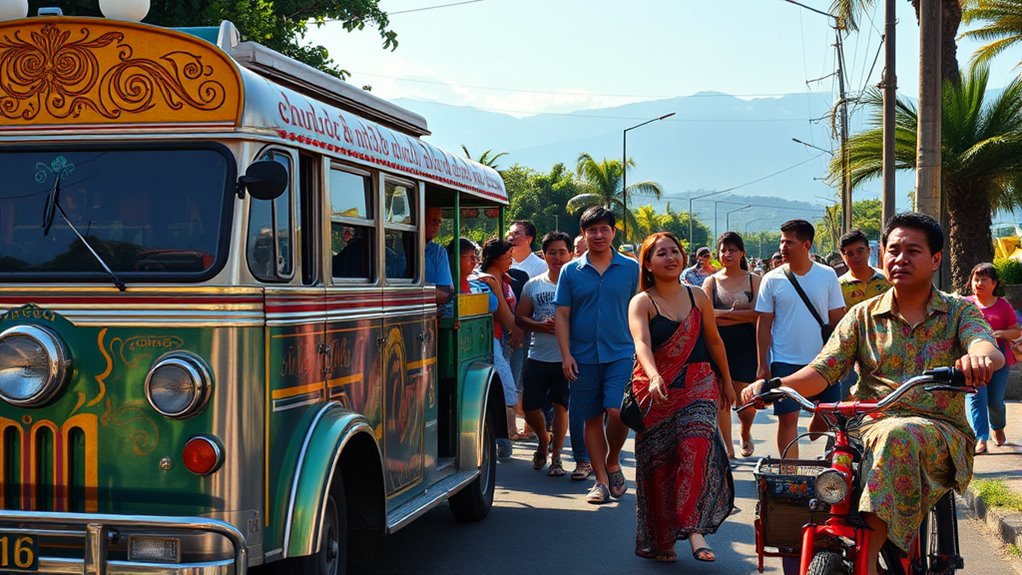
In the Philippines, unique transportation experiences await you as you navigate the vibrant streets and scenic routes.
Hop on a jeepney, those colorful, modified military vehicles that showcase local art and culture. For shorter trips, try a tricycle—a thrilling ride combining a motorcycle with a sidecar.
If you’re up for a lively atmosphere, take a bus filled with music and festive lighting. Mini buses offer a chaotic yet exciting journey for quicker distances.
Don’t miss the chance to ferry between islands, perfect for island hopping. Each mode immerses you in the daily lives of locals, making your travels not just a journey but an adventure rich in culture and connection.
Enjoy every moment!
Tips for Navigating Public Transport
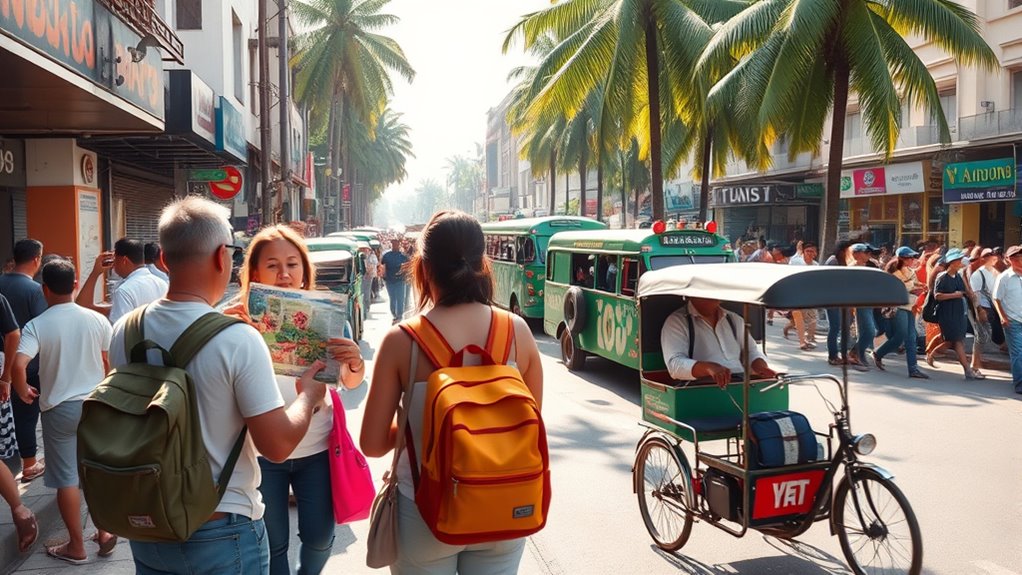
Experiencing the vibrant modes of transportation in the Philippines is just the beginning of your adventure.
To navigate effectively, start by downloading navigation apps to familiarize yourself with routes and schedules. Be flexible; traffic can lead to delays, so allow extra time for your journeys.
When using jeepneys or tricycles, always pay in cash, while buses might require tickets. If you prefer convenience, opt for metered taxis. During peak hours, try to travel outside rush times to avoid congestion.
It’s also wise to write down your destination in Filipino to help with communication.
Finally, stay alert in crowded areas and keep an eye on your belongings to guarantee a safe and smooth travel experience.
Frequently Asked Questions
What Are the Best Apps for Navigating Public Transport in the Philippines?
If you’re traversing public transport in the Philippines, you’ll find several essential apps.
Start with Sakay.ph for detailed routes and real-time updates. For train schedules, ikotMNL is your go-to.
When it comes to ride-hailing, Grab is a must-have for convenience, while MiCab offers local taxi options.
If you’re in Mindanao, Hirna provides reliable taxi bookings.
These apps can make your travel smoother and more efficient!
How Do I Report Lost Items on Public Transport?
If you’ve lost something on public transport, notify the conductor, driver, or station manager right away.
You’ll need to file a formal report with local authorities to assist in recovery and deter false claims. Keep any receipts or documentation related to your item as proof of ownership.
Regularly follow up with the transport officials or authorities to check on the status of your lost item. Quick action increases your chances of getting it back.
Are There Any Transportation Discounts for Seniors or Students?
Imagine saving money while traveling! Yes, you can!
Seniors over 60 and students in the Philippines are entitled to transportation discounts. Seniors get a 20% fare discount on public transport, including buses and taxis, by presenting a valid Senior Citizen Card.
Students can also enjoy similar discounts under the Student Fare Discount Act. These benefits make traveling more affordable, so don’t forget to bring your ID when you hop on board!
What Safety Precautions Should I Take While Using Public Transport?
When using public transport, you should prioritize your safety. Always inspect the vehicle before boarding and guarantee the driver has a valid license.
Keep your belongings secure to avoid pickpockets, and be cautious of your surroundings, especially when traveling alone.
Use taxi meters to avoid overcharging, and negotiate fares in advance for tricycles and jeepneys.
Trust your instincts; if something feels off, don’t hesitate to remove yourself from the situation.
How Do I Find the Nearest Bus or Train Station?
Finding the nearest bus or train station is like hunting for treasure in a bustling city.
Start by asking locals or taxi drivers—they’re your compass in this urban maze. Major terminals like Ceres Bus Liner often nest near city centers, so keep your eyes peeled.
Use OpenStreetMap or local apps to chart your course, and don’t forget to grab a physical map for backup when the signal falters.
Happy exploring!
Conclusion
To sum up, exploring the Philippines through its public transportation can be an adventure in itself. For instance, imagine hopping on a jeepney in Cebu, surrounded by locals, and feeling the vibrant atmosphere as you navigate the city. You’ll not only save money but also immerse yourself in the culture. So, embrace the chaos, enjoy the ride, and don’t hesitate to ask for directions—Filipinos are known for their hospitality and are enthusiastic to help!
